On-Chain Barter: Let’s Get Back to the Rhythm of Crypto
In this article, we propose two interrelated theoretical threads: the first traces the evolution of DeFi’s liquidity technology, while the second emphasizes the transformative impact of on-chain barter from an economic history perspective.
The purpose of this article is to confirm that a profound DeFi revolution is imminent: we just need a little more patience. Those visionary builders who can hold on to their ideals will eventually be rewarded by the market.
We meticulously trace the development of the decentralized exchange (DEX) market to illustrate that the emergence of on-chain barter trading is no accident and that on-chain barter trading is a true game-changer.
It represents an important chapter in the history of Web3 builders. Achieving its functionality requires significant innovation and improvement, not only within DEXs but also at the underlying infrastructure level.
If on-chain barter becomes a significant historical milestone, we believe that all related efforts and contributions should be properly commemorated.
1. Have We Lost Control of the Rhythm of the Crypto Industry?
Since January 2023, driven by ETF approvals and new expectations for quantitative easing, Bitcoin has fallen to a low point and rebounded to new highs. However, most altcoins have not shown stronger upward momentum as they did in the past when BTC created room for imagination.
Some investors ridicule true innovation due to the high valuation and low liquidity performance of the VC token market, viewing the crypto world as a realm of crime. At some industry conferences, individual industry leaders even bluntly refer to the entire industry as similar to a casino.
Many crypto enthusiasts are intoxicated by the excitement of PvP (player vs. player). The overall market performance shows that memecoins are sought after in the early stages of a bull market, while value tokens are ignored and absent throughout the bull market.
In this bull market, many veterans feel that this time is indeed different, even surpassing the industry’s chill in 2018-2019. Some developers are confused and begin to question their original intentions: can cryptocurrencies really change the real world? Since last year, with the rising prominence of AI, many have turned their attention to artificial intelligence, while more remain hesitant.
Why is this crypto market different?
We cannot ignore the influence of venture capital and team greed, misaligned interests, unethical behavior, and short-term thinking. The market has long been a dark forest. Besides the code, there are not many rules to regulate participants. Although these problems have long existed, they are not enough to explain the lackluster performance of this bull market.
Therefore, we propose an additional reason: the self-expansion within the crypto market is no longer sufficient to provide the necessary liquidity for our crypto ecosystem. Please see the figure below:
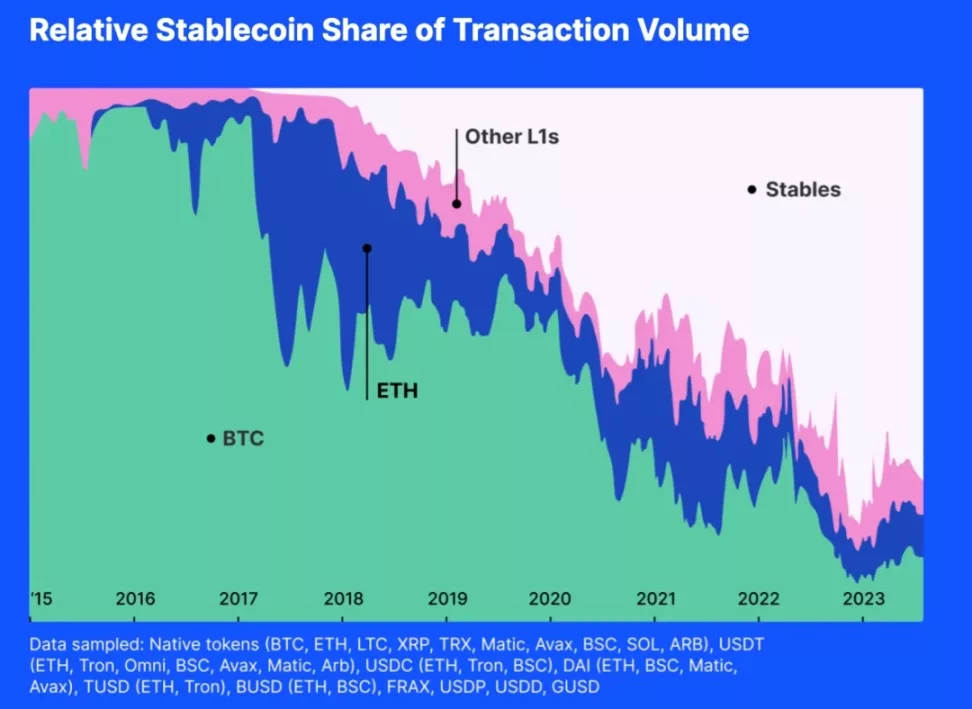
The figure above shows the activity of various crypto general equivalents. From the graph, it can be seen that since 2018, the market share of non-stablecoins has been continuously falling. In terms of trading volume, most transactions in the past one or two years have been provided by USD stablecoins. If the market value of USD stablecoins cannot continue to expand, as new coins are issued, the liquidity pool will be drained.
In the past, Bitcoin and Ethereum were largely the general equivalents of the market. Bitcoin and Ethereum could become liquidity for others, and during the bull market stage, altcoins and mainstream coins that acted as liquidity would spiral upwards, mutually reinforcing each other.
In such a token-led liquidity market structure, altcoins rarely lacked liquidity. Coming back to the present, most trading pairs are linked to USD-pegged stablecoins. Even explosive growth in the value of Bitcoin or Ethereum is useless; the status of stablecoins makes it difficult for BTC and ETH to inject liquidity into other tokens.
The Pricing Power of Cryptocurrencies Falls into Wall Street’s Hands
All USD-pegged stablecoins and other compliant financial instruments are bait. Cryptocurrencies follow Wall Street’s clock.
In October 2014, Tether began offering a stable digital currency that bridged the gap between cryptocurrencies and fiat currencies, providing the stability of traditional currencies and the flexibility of digital currencies.
Now it has become the third largest token by market value. Additionally, USDT has the most trading pairs in the index, ten times that of Ethereum or wBTC.
In September 2018, Circle partnered with Coinbase to launch USD Coin (USDC) under the Centre Consortium. Pegged to the US dollar, each USDC token is backed by dollar reserves at a 1:1 ratio. As an ERC-20 token, USDC enables seamless transactions and integrates with various decentralized applications.
On December 10, 2017, the Chicago Board Options Exchange (CBOE) launched Bitcoin futures, which, although settled only in USD, can influence Bitcoin spot prices, especially given that Bitcoin’s open interest now accounts for 28% of the global market.
Wall Street not only physically influences the crypto market but also psychologically affects liquidity within the crypto market. Do you remember when we started paying attention to the Federal Reserve’s stance, Grayscale’s trust discount, the FOMC’s “dot plots,” and the cash flows of BTC-ETFs? All this information psychologically influences our behavior.
Stablecoins are the bait thrown by the US government. Since we accepted USD-pegged stablecoins as a means of providing liquidity, they started accumulating consensus, replacing the liquidity role of native crypto tokens, competing with and undermining the credibility of other tokens, and gradually dominating the general equivalents market.
In this way, we lost control of our market rhythm.
I am not here to blame USD-pegged stablecoins; on the contrary, this is a natural result of fair competition and market choice. Tether and Circle help investors directly invest in USD-pegged assets on the chain, letting them bear risks equivalent to the US dollar and providing more choices for investors.
Markets are struggling for liquidity! Losing control of liquidity means losing control of the rhythm of the crypto industry.
2. The Millennial War for Liquidity
Liquidity is Always a Fundamental Demand
Liquidity is a fundamental characteristic of markets, and any innovation that improves market liquidity is a significant historical advancement.
According to organizational theory, a market is defined as a structured environment where buyers and sellers exchange goods, services, and information. This environment is guided by established rules, norms, and institutions to facilitate coordination, reduce transaction costs, and support efficient economic interactions.
Liquidity is crucial for market organization because it directly affects the market’s efficiency, stability, and attractiveness. High liquidity reduces transaction costs by minimizing slippage and increasing trading volume. Highly liquid markets also exhibit greater price elasticity, better prices, and attract more participants, contributing to more accurate price information.
Information economics emphasizes the role of markets in information discovery. In ideal markets, information flows freely, enabling participants to make informed decisions, optimize resource allocation, and achieve equilibrium prices. Highly liquid markets generate reliable information that aids in more efficient resource allocation.
Whether it’s price discovery efficiency, price stability and resilience, or lower transaction costs, these characteristics enhance a market’s ability to attract participants. Market attractiveness, in turn, further enhances market liquidity, improving the market’s overall efficiency. Therefore, improving liquidity is essential for any market.
Money as an Innovation to Address Liquidity Problems
Academically, there are two mainstream theories about the origin of money. One theory sees money as a convenient means of exchange, widely accepted by the public and scholars. The other, from David Graeber’s Debt: The First 5,000 Years, posits that money originated from debt relationships, while also acknowledging money’s role as a universal equivalent.
In addition to Glynn Davies’ A History of Money: From Ancient Times to the Present Day and Karl Marx’s Capital: Volume 1, other sources hold similar views on the origin and evolution of money.
For example, Niall Ferguson, in The Ascent of Money: A Financial History of the World, points out that the development of money originated from the need for efficient exchange systems, starting with barter and evolving into more complex systems using items with intrinsic value.
Similarly, in Money: The Unauthorized Biography, Felix Martin discusses the concept of money as a social technology developed to meet the need for a more efficient exchange system. Martin, like Marx, views money as a universal equivalent, originating from a common commodity during the barter era.
Finally, David Graeber’s Debt: The First 5,000 Years presents a unique perspective, suggesting that money evolved from systems of debt and obligation that predated the invention of money itself.
However, Graeber’s view still aligns with the core idea that money was created as a universal equivalent to facilitate the exchange of goods and services.
These resources further emphasize the role of money as a medium of exchange, echoing the views of Davies and Marx.
In summary, the academic consensus on money is that its function as a universal equivalent emerged to solve liquidity problems in markets. The debate lies in whether the initial carriers of money were commodities or debts.
Money was an ancient elite’s response to liquidity problems before the advent of the internet of value, a means to enhance liquidity.
In the past, the old forces that equated money with liquidity rarely attempted to improve the market’s organizational structure to achieve better liquidity conditions. They never considered how to build market liquidity without money. Perhaps they have been confined like fleas in a lidded box for so long that they have forgotten how high they can jump.
DEX: The Force of Change
The primary goal of any market is to provide the most accurate prices and the most efficient resource allocation. Every component, mechanism, and structure is designed to achieve this purpose. Throughout history, humans have continually created new methods to improve market efficiency.
Over the centuries, markets have undergone significant changes. Price generation mechanisms have been upgraded multiple times. To meet diverse economic needs, markets have developed various settlement procedures, such as dealer markets, order-driven markets, brokered markets, and dark pool markets.
With the advent of blockchain technology, we encountered new constraints and new opportunities to solve liquidity problems. Here, we can create innovative methods to address exchange demands and provide liquidity for tokens.
Summary: The Trilemma of Modern Token Exchanges
Contemporary token exchanges face a trilemma: 1) sufficient liquidity, 2) efficient pricing, and 3) decentralization.
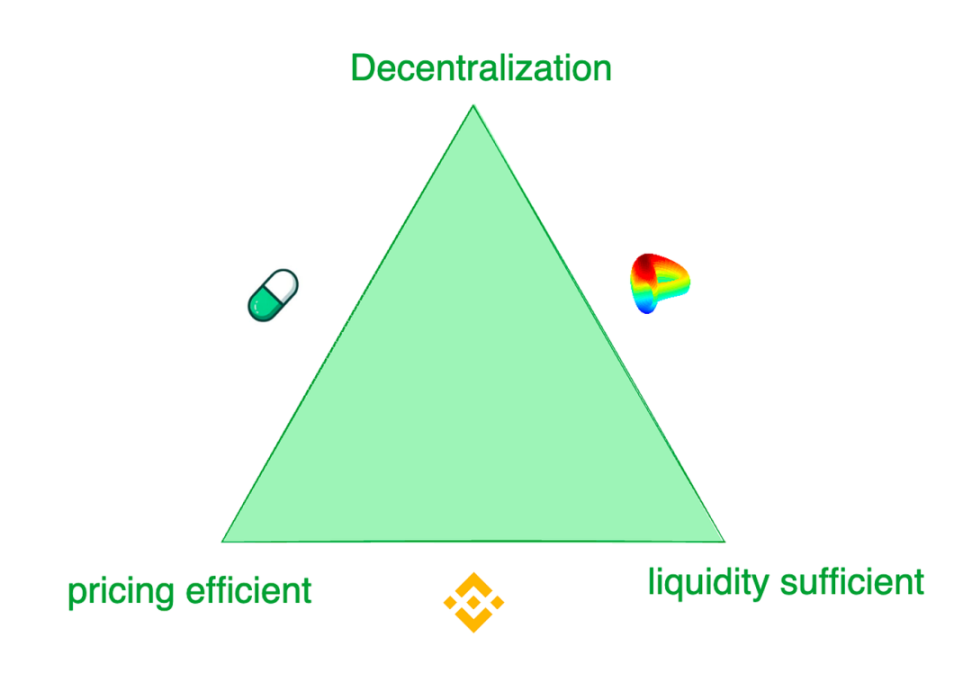
While centralized exchanges (CEXs) like Binance offer the best trading experience, their users suffer from risks of fraud and monopolistic exploitation. Even the former world’s second-largest exchange, FTX, is currently bankrupt and liquidating due to misappropriation of user assets.
Exchanges with better liquidity often charge hefty listing fees and impose stringent terms on project teams. In contrast, decentralized exchanges (DEXs) are more flexible, designing different mechanisms to cater to various demand scenarios.
For example, Pump.fun is known for its highly responsive token supply curves, while Curve provides the best liquidity in most cases, not necessarily price discovery sensitivity. These exchanges adopt various models to meet the trading preferences of their diverse target customers. Undeniably, each has its focus and sacrifices.
Attempts to Create On-Chain Liquidity
Decentralized exchanges have made significant progress in addressing this trilemma and other on-chain trading challenges through innovation. The long march begins with the first step: establishing on-chain liquidity. Here’s a simple industry overview: Uniswap is the benchmark in this niche.
The innovation of the bonding curve marked the beginning of a new era. Before Uniswap’s “X*Y=C” curve, decentralized exchanges used order books to settle on-chain trading demands. Subsequent automated market makers (AMMs) followed Uniswap’s exploration direction, creating liquidity pools.
In Uniswap V2, liquidity from different trading pair pools is connected algorithmically. Uniswap V3 introduced segmented liquidity pools, allowing users to define the price ranges they want to provide liquidity for. Uniswap V4 further advanced this by offering custom liquidity pool solutions.
For assets with relatively stable trading prices, the market demands more concentrated liquidity supply. Curve Protocol, specializing in stablecoin trading, developed its own supply liquidity curve to provide more token liquidity around predetermined equilibrium points.
To address the challenges of pooled liquidity, Curve Protocol invented a multidimensional formula, allowing users to place more than two tokens in a single liquidity pool, thereby sharing liquidity among all tokens in the pool.
In practice, centralized exchanges (CEXs) exhibit better liquidity and pricing efficiency. On-chain pricing systems usually lag behind off-chain CEXs. Hashflow, with the help of oracles, established professional market maker pools (PMMs) to connect on-chain and off-chain liquidity.
However, for small-scale tokens, traditional bonding curves are costly, and the contradiction of liquidity funding costs is more pronounced. Friend.tech designed a steeper bonding curve to cater to small investors who prefer price appreciation over ample liquidity.
As token value scales increase, investor preferences shift towards liquidity. Inspired by this, Pump.fun uses steep curves for lower token values, but as values increase, the curves transition to different slopes or even different curves.
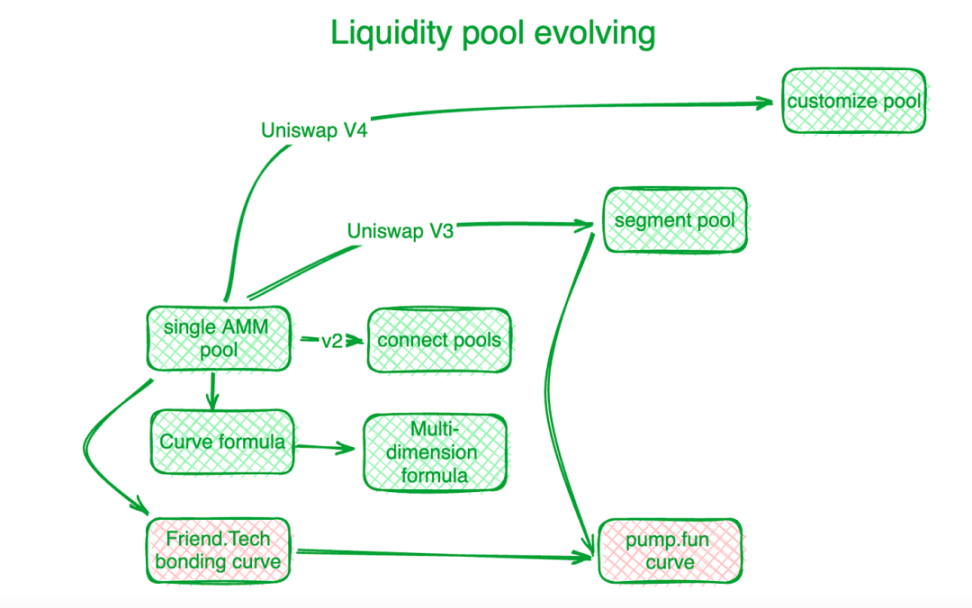
MEV: The On-Chain Liquidity Race
MEV is another battleground for decentralized exchanges.
Maximum Extractable Value (MEV) refers to the profit miners or validators can obtain by including, excluding, or reordering transactions within the blocks they generate. It can be seen as a cost of liquidity. In liquidity pools, each exchangeable token (liquidity) is distributed along the price scale, and liquidity for each price span is limited. Those who interact with liquidity pool contracts earlier gain an advantage by obtaining better prices. Thus, MEV is inherently linked to liquidity issues.
MEV manifests in decentralized trading as the extraction of advantageous liquidity through transaction reordering. This competition increases the efficiency of on-chain trading but also harms the interests of participants.
To retain as much transaction value as possible in decentralized exchanges and return it more completely to participants, developers have built algorithms and mechanisms at the application layer to intercept MEV generated by transactions.
Flashbots, a veteran in MEV management, focuses on the distribution of node revenue. To ensure transparent and efficient MEV distribution, they established an MEV auction system at the node level. Eden Network pursues similar goals.
KeeperDAO combines MEV extraction and staking, allowing participants to benefit from MEV while protecting users from its negative effects. Jito Labs, a liquidity staking project on the Solana network, also addresses this issue.
Leading projects like Cow Protocol, including UniswapX and 1inch Protocol Fusion, utilize auction interaction rights to retain MEV within the transaction process, rather than letting this value flow to the node bookkeeping level. Intercepting MEV protects active traders and AMM liquidity pools, eliminating the previous dilemma caused by DEX bribing nodes and losing MEV.
Liquidity Fragmentation Calls for Agents to Solve the Problem
As mentioned earlier, token liquidity is dispersed across different blockchains or Layer 2 solutions in various custom pools controlled by different protocols. Polygon proposed an aggregation layer concept to collect liquidity from different layers.
Initially, some DEX aggregators emerged to integrate liquidity from these different pools. However, after accumulating sufficient traffic, a more efficient method is to create platforms that facilitate competition, such as 1inch and Cow Protocol.
Additionally, batch auction mechanisms enhance the role of agents. They introduce a new market mechanism to alleviate liquidity constraints. In practice, traders can place orders at limited prices within a specified period.
The batch auction smart contract collects these orders and bundles them into a batch. Then, the smart contract allows agents to bid on these batches. The agent offering the best price wins the opportunity to settle all potential trades within the batch.
CoW Protocol Batch Auction Mechanism Explained
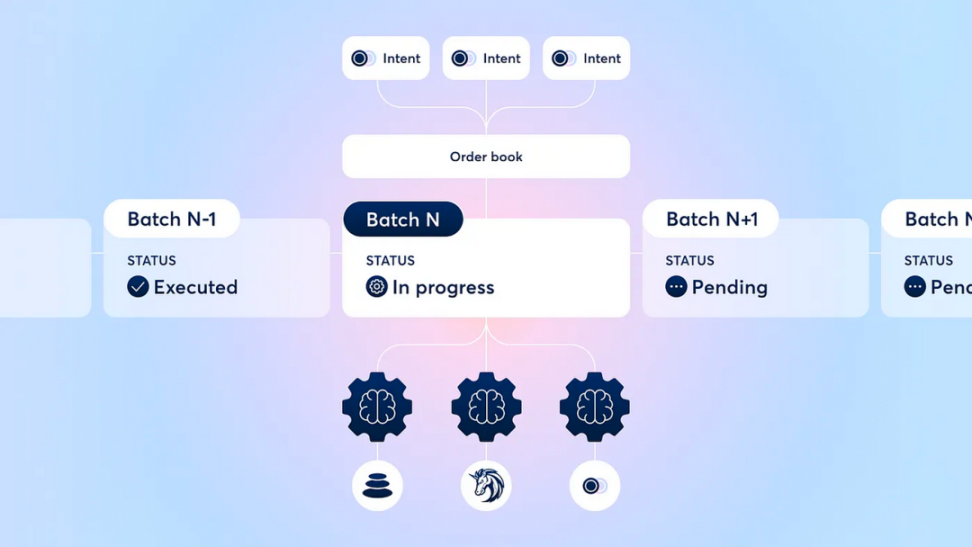
Batch Auctions: The Culmination of DEX Development
After years of DEX development, the industry has embraced methods like batching, auctions, and order matching to optimize transaction outcomes for all participants.
The specific implementation of auction mechanisms varies, but generally, they transfer the complexity of optimizing exchange outcomes to professional participants and redistribute the surplus to relatively immature exchangers.
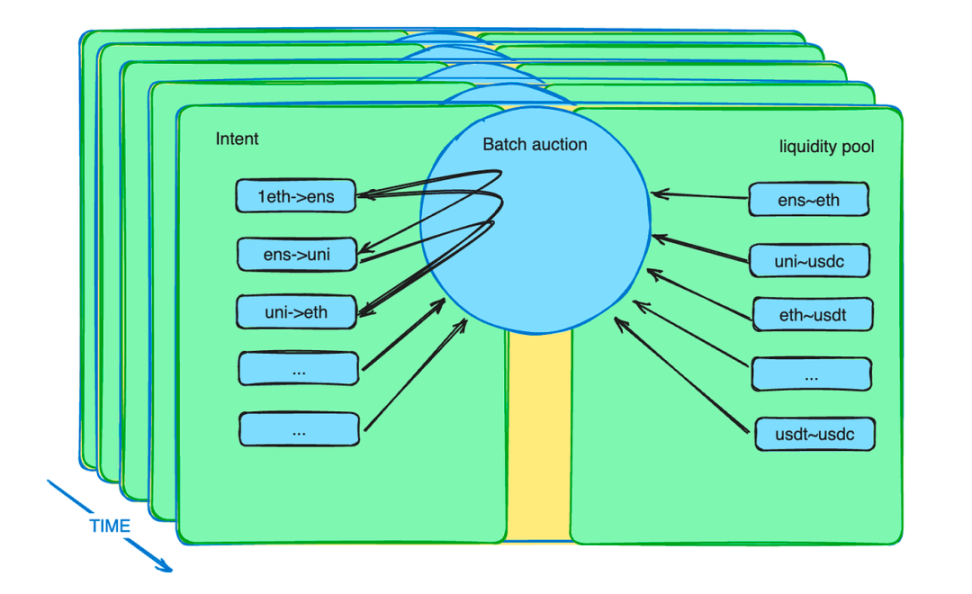
These auctions can address many DEX challenges from multiple aspects.
In addition to MEV redistribution mentioned in the previous section, batch auctions can do much more. Traders do not send instructions to the smart contract but rather an intention. This intention can last for several minutes.
These intentions are bundled into a batch and proposed to a group of competing specific trading agents. We know that intentions are vast, liquidity pools are diverse, and optimization is a challenge. Leaving professional matters to professionals can improve system efficiency.
Batch auctions maximize value efficiency by sacrificing time efficiency (each transaction intention typically lasts a few minutes), forming a differentiated competition with CEXs.
Batch auctions retain MEV within the exchange, thereby benefiting transaction participants. Even, batch auctions, by relaxing time constraints, break down cross-chain and on-chain/off-chain liquidity barriers.
What’s more? Barter is back on stage!
3. The Return of Barter Trade
As the ancestor of all cryptocurrencies, Bitcoin defines itself as a form of currency. Decentralized markets are an emerging field with no explicit consensus constraints. Barter is a native trading mode for cryptocurrencies, which naturally requires no education for users.
Decentralized exchanges (DEXs) are often referred to as “swap” platforms. In their trading mode, there is no pre-determined universal equivalent role. Traders do not need to use fiat currency or stablecoins as intermediaries. At the liquidity pool level, any trading pair is allowed. Traders can use any token they like to exchange for other tokens, bearing the cost of liquidity inefficiencies.
However, relying solely on liquidity pools for barter trade has significant limitations. There are not enough pairs for all types of barter transactions. Due to the structure of liquidity pools, liquidity deployment takes a long time, making it difficult to find equilibrium prices.
Consequently, liquidity must be deployed over a wider price range, leading to scarcity compared to the time-limited demand of intentions. This is where intentions and batch auctions come into play.
Suppose there are multiple potential trading intentions that can meet each other’s needs, supplemented by liquidity from pools. In this case, barter trade will return to the market in a more efficient state. With improved scalability of web3 infrastructure and the inclusion of more commodities and financial instruments in web3, batch auction smart contracts will capture thousands or even millions of trading intentions per second.
Any token can be used to settle other tokens. We will be free from the liquidity constraints imposed by the dollar in a universal context.
Batch Auctions: The Key to On-Chain Barter
The revival of barter represents a renaissance. Its resurgence is not out of nowhere but in response to market demand.
Historically, when money was invented, traders found it difficult to find direct barter opportunities that met their immediate needs. Thus, they exchanged goods for a universal equivalent (money) and then used that to buy what they truly needed in another transaction. Once this exchange mode was widely accepted, it forced real barter needs to be split into at least two steps, thoroughly replacing direct barter markets.
Today, on-chain barter demand exists in the form of short-term intentions. Batch auction smart contracts collect these intentions. Anyone, whether human or AI agent, can meet the entire transaction demand as long as they provide the best bid.
If intentions match, there is no need for stablecoins pegged to the dollar. Tokens retain their utility and share liquidity as before. This matching of barter demand is based on a global market and stronger information matching capabilities, extending from the cultural tradition of cryptocurrency barter.
In the short term, the existence of intention time spans allows arbitrageurs to transfer liquidity across chains, from off-chain to on-chain. For example, an algorithm that discovers price differences between different chains or between DEXs and CEXs can buy at lower prices and sell at higher prices within a specified time.
It might need to use financial instruments to hedge market risks to achieve a risk-free state. However, in the future, when on-chain, off-chain, and cross-chain transactions can synchronize, all transactions can be executed simultaneously. This can eliminate risk costs and provide the best experience for traders.
Why Barter under Batch Auctions is a Milestone for the DEX Era
The reason is simple. If we look back at the history of money, coinage rights were initially private. According to Debt: The First 5,000 Years, debts could be personal. Even in modern times, as detailed in A Monetary History of the United States, 1867-1960, private individuals once minted silver coins.
However, today, all credit is issued by the Federal Reserve. Even Bitcoin is priced in dollars, which is unfortunate for the times. The dollar has overshadowed the brilliance of cryptocurrencies. Barter trade offers an opportunity to reclaim this position, marking the significance of the barter revival era.
The development of decentralized exchanges (DEXs) gives us confidence that we can ultimately surpass centralized exchanges (CEXs). In the last DeFi summer, it was widely believed that DEXs would surpass CEXs in due time.
How many people hold this belief today? If we study the development of DEXs, the introduction of batch auctions is no coincidence. It is a deliberate step toward solving liquidity problems and a stage achievement of continuous technological iteration by DEXs. DEXs have evolved from merely having liquidity pools to a comprehensive liquidity system with different participant roles, specialized components, and permissionless composability.
This progress is achieved through the efforts of predecessors. By relaxing time constraints and creating conditions differentiated from centralized exchanges, we see more possibilities. It even restores my confidence in DEXs surpassing CEXs.
A business cycle has passed, and while the giants of DeFi remain outwardly unchanged, they have undergone internal transformation. Batch auctions are a significant milestone, as important as the invention of liquidity pools. I believe they can achieve the dream of DEXs surpassing CEXs. When barter becomes the primary trading mode again, we can reclaim control of our market rhythm.
4. Conclusion
In discussions about the future with many industry leaders, I found a general sense of confusion and a lack of confidence due to the market’s neglect of technology.
Think about it: when did the industry’s development become defined by speculators’ wallets?
Decentralized exchanges (DEXs) are just a small part of the vast DeFi industry. If we observe closely, we will find significant and exciting progress in DeFi and other fields. As long as technology continues to advance and develop without stopping, what is there to worry about? Dreams will certainly come true.